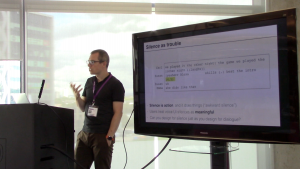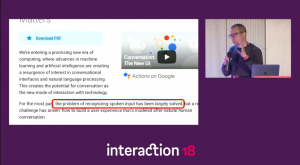This is a short story about how our team—myself, Martin Porcheron, and Joel Fischer —disseminated our research on voice interfaces to UX and design practitioners through a varied campaign spanning over a year and a half to the present.
It began with a technology field trial that formed part of Martins PhD, during which he collected many hours of audio recordings of Amazon Echo use in domestic settings where the devices were deployed for a month. While working towards our first major academic milestone — a CHI 2018 paper (which was submitted in September 2017), we also began discussing and presenting early versions of this work-in-progress with practitioners.
This engagement with practice grew from exchanges with the BBC UX&D design research team with whom we discussed our emerging research and its results. Subsequently this led to us conducting a BBC UX&D “Studio Day” workshop that enabled us to do a more focussed presentation, coupled with a practical exercise for groups of UX&D practitioners, to consider issues raised when designing for voice interfaces. Performing this mini-workshop helped engender a more meaningful discussion than simply presenting what were then very preliminary results.

We presented our work publicly to the Cambridge Usability Group (CUG), and to a UX agency in London. Both activities led us to consider taking the material to a larger conference.
To begin with, these initial engagements with smaller audiences of practitioners enabled us to gauge what might be interesting and relevant for them, as well as providing us with a better sense of what kind of involvement with voice interfaces was realistic for designers. They also enabled us to gradually ‘prototype’ our ideas and presentational formats in a way that integrated our (ongoing) work, allowing us to establish a ‘feedback’ between the research side of things (e.g., developing papers) and practitioner-facing talks.
With our CHI 2018 paper accepted, I then presented our work to Interaction18, a large interaction design industry conference organised by the Interaction Design Association (IxDA). The tight 15 minute slot offered by IxDA required significant sharpening in order to maximise our work’s relevance and impact. My talk at Interaction18 was recorded and made more widely available by the conference organisers. I also decided to transform it into a Medium post which I made available soon after. This resulted in a positive uptake, 1.6k+ views on Medium and counting.

Presenting at a reasonably high-profile event for UX and design practitioners let us establish a formula—in miniature— that we could be confident with, that mostly seemed to ‘work’ for people and be of relevance – as evidenced by in-person feedback and further enquiries afterwards. Critically, it also generated further interest from practitioners in the form of invitations to speak about our work at other venues. In this way, smaller UX conferences and meetups followed and have built on this: The Research Thing, London in April; HCID Open Day at City, University of London in May; The Design Exchange, Nottingham in August; and the Service Design Meetup, London in October.
Whilst not clear as to what all this ultimately will lead to, we have a number of other future events and publications in development. It proves difficult to track and trace our impact on UX and design practitioner communities, even though we can capture how our learning as academics that engaging with practice has helped shape the research in various positive ways: increased conceptual clarity, focus, and a better appreciation for the value of different formats. All of these in turn help sharpen our standard academic dissemination and research approach.

